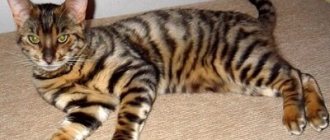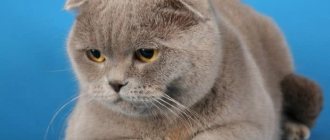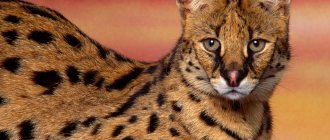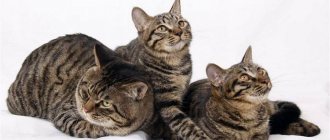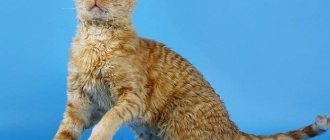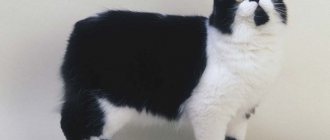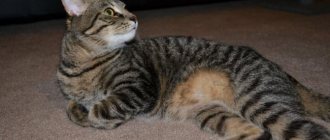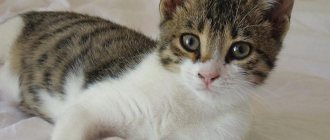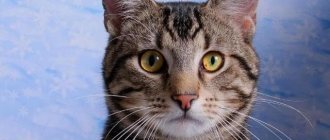Havana brown
This is a relatively young breed that appeared in Europe in the 19th century. Great Britain is considered its homeland. Local breeders decided to breed an animal whose body would be covered with chocolate-colored fur. To do this, they crossed representatives of several different breeds, including Russian Blue, brown Siamese and domestic black cats. In the 50s of the 20th century, these animals were brought to America. A few years later they were officially recognized as an independent breed.
Havana Browns are charming brown cats with a playful disposition and a gentle voice. Their weight ranges from 4-6.5 kilograms. The elongated head has raised whisker pads, bright green eyes and forward-leaning ears. The animal has a strong, muscular body with soft, shiny fur, the color of which varies from red-brown to warm chocolate.
Features of color
The formation of color is a complex biochemical process that begins in the embryonic stage of embryonic development. The color of a future kitten's fur depends on the interaction of dozens of genes.
- Chocolate color is one of the forms of black, for which the B gene (black) is responsible. In combination bb it gives the color range of a brown monochrome, capable of taking on different tones.
- Next, the D gene enters the process. In the dominant form, it blocks any lightening, but in the recessive version, dd opens the way for a change in the color of the main pigment.
- The bb (brown) allele and the dominant D gene are chocolate color. When the combination bb+dd occurs, the coat lightens and turns purple.
- Black always dominates brown.
- Within colors there are also divisions into tones. Dark chocolate is formed by the b allele, and the lighter cinnamon (cinnamon) received the b index
- Option b partially suppresses b1, making color fixing a very difficult task. Therefore, kittens change color over time, and only in an adult animal can one accurately determine the color of the coat.
- In nature, cats have two coloring pigments - black eumelanin and red pheomelanin. But the first one has two additions - brown (dark chocolate) and cinnamon (cinnamon color). The color saturation of the hair is affected by the shape of the dye capsules and the density of their arrangement in each hair.
Experienced breeders always accurately determine what colors cats will have in their litter. Brown color is considered rare and complex, but in some cases it predictably appears when breeding chocolate cats.
This is interesting! Once upon a time, felinologists tried to get brown offspring from red (ginger) cats. But the experiments had to be stopped due to unstable results. Only some varieties of black cats give birth to chocolate babies.
Persian cat
These magnificent animals have a very long history. Their development began around the 16th century. The first representatives of this breed came to Italy from one of the Persian provinces. Subsequently, they gained extraordinary popularity among European breeders and quickly spread throughout the continent.
These animals have a memorable appearance. The average weight of Persians reaches 6-8 kilograms, but larger individuals are also found in nature. On a rounded head with thick cheeks, strong jaws, a powerful chin and a convex forehead, there are small ears, expressive shiny eyes and a short, upturned nose. The large body with a wide back and massive chest is covered with thick long hair. As for color, the standard allows several options. But black, white, red, blue, cream and brown cats are especially popular.
Purchase: recommendations
Burmese kittens must be four months old at the time of purchase.
This way you can protect yourself as much as possible from purchasing a sick pet with genetic abnormalities, which will definitely manifest themselves at this age.
Burmese kittens
The kitten must have a color that meets the standard without white spots. The paws should be straight and strong, the eyes should be clear, the tail should not be kinked or damaged, and the belly should not be swollen.
The purchased animal must be active and easy to contact. You can try playing with it.
It is better to think in advance what gender and color you would like to get a pet. You should also immediately decide on the purpose of acquisition - for exhibition activities and breeding (show class) or just for yourself (pet class and below).
Where to buy, what to look for
Burmese are popular in Russia; many nurseries breed them. Basically, the sale of Burmese kittens is carried out by prior arrangement.
You should choose a nursery in advance. You can contact the club for recommendations on thematic forums.
On the page of the nursery’s website you can study the pedigrees of the parents, trace the offspring of the couple’s previous litters, and see how well they are exhibited.
Burmese are popular in Russia, many nurseries breed them
Burmese cat price
The price of purchasing a Burmese kitten depends on:
- titles and quality of ancestors' pedigrees;
- color,
- age of the animal;
- class;
- presence of deviations from breed standards;
- gender
The price of a show-class kitten is 80-100 thousand rubles in the Moscow experimental nursery from producers raised and purchased abroad.
Pet class kittens can be purchased for up to 40,000 rubles. Breeding class kittens can cost up to 25,000 rubles.
Shorthair exotics
These unpretentious beautiful animals are close relatives of the Persians. They were bred in the 1960s through the efforts of American breeders.
Shorthaired exotics are large cats with a strong, muscular body of a square format, under which there are short, thick limbs. The round head with convex cheeks and a massive lower jaw has widely spaced eyes, small ears and a miniature upturned nose. The entire body of representatives of this breed is covered with thick, silky short fur with dense undercoat. As for the color, it can be anything. But the most common ones are red, blue, white, cream and brown-white cats.
Shorthaired exotics have a calm, friendly disposition. They do not tolerate loneliness well, but they will never bother you with tenderness. Thanks to their natural balance and serenity, these non-aggressive animals easily adapt to any conditions.
Scottish cats
These animals appeared as a result of a natural genetic mutation. It occurred more than half a century ago in an ordinary white cat named Susie. Subsequently, offspring were obtained from her. One cat from this litter ended up in the family of shepherd William Ross. It was she who became the ancestor of the new breed.
Scottish cats are animals with a strong body, a wide chest and a strong neck. On a round head with a well-developed chin and pronounced whisker pads, there are large eyes and a neat nose. The ears of representatives of this breed can be either straight or downward. The entire body of these animals is covered with a beautiful thick six. As for color, many options are allowed here. Despite this diversity, black, blue and brown Scottish cats are the most common.
Representatives of this breed are distinguished by their unobtrusive, affectionate character. They are extremely clean and can live even in a small apartment. At a young age, these animals are very active and playful. But over time they become more phlegmatic.
Black color standards
According to all international standards, the black color code is n (sil, ebony, wild, sable). The outer coat, as well as the undercoat of the animal, must be evenly and evenly colored, each hair painted completely from the base to the very tip. No white or colored inclusions are allowed (spots, stripes, stains, etc.).
The coat of black cats should have a uniform color, without any spots or inclusions.
The nose, as well as the pads on the paws, are only black. Whiskers (vibrissae) are only acceptable if they are black. The eyes of cats with tar coats most often have all shades of yellow and green (from bright emerald green to olive or light sand).
The eyes of black cats are most often yellow-orange.
As they grow older, the color of the iris of pets' eyes becomes more faded, as if fading.
Our neighbor has several cats. They all prefer to lead a free life and are constantly on the street. One black cat has taken a fancy to our lawn and often basks on the grass in the sun. By autumn, its skin takes on a dirty brownish-reddish tint, since cats' fur also fades, just like people's hair. After the autumn molt, the pet again becomes coal black. Animals with dark coats that participate in exhibitions are recommended to be exposed to the open sun as little as possible. A balanced diet greatly influences the quality of the coat. In winter, the neighbor's cat, who loves to hunt mice and eats natural food, literally has shiny and glossy fur.
Black kittens are often born with blue eyes
Video: everything about black cats
British cats
These animals are distinguished by their strong build with a wide chest and short legs. The round head with well-defined cheekbones has erect ears and large eyes. The entire body of the British is covered with beautiful short fur with a thick undercoat. Representatives of this breed often include tortoiseshell, red, lilac, cream, black and dark brown cats.
The British are very affectionate and clean animals that quickly get used to their owner. At the same time, they calmly tolerate short separation from the owner. These calm, balanced cats do not require complex care. They are not picky when it comes to food, and happily eat both industrial and natural food.
Diseases
Despite the fact that this breed was bred artificially, Yorkie chocolate cats rarely develop serious health problems. Their immunity is very resistant to both genetic and chronic diseases.
The most common ailments are related to the condition of the coat, teeth, ears and joints.
- Hair problems are immediately obvious. It becomes dull, shreds of it are found here and there. Dandruff, bald spots appear, and small rashes and traces of their vital activity appear on the skin. Most often, the reason is that the animal is infected with lice, lice or fleas. If your cat goes outside for a walk, there is a high risk of picking up parasites there. But pets are also under threat: you, without meaning to, can bring insects on clothes or shoes from the street.
- Symptoms of ear mites: brown plaque in the auricle. The parasite that has settled there feeds on dead cells and sulfur, gradually causing an inflammatory process and the occurrence of eczema. For treatment, the doctor prescribes antibiotics and rinses.
- Allergies in chocolate cats are not that rare. This is due to the fact that the owners do not adhere to the diet and feed the cat “at random”, from their table. Sometimes flea bites can also be the cause. The cat begins to scratch uncontrollably, blisters and eczema appear on the body. It is difficult to identify the disease on your own; only a doctor can do this. Treatment will consist of eliminating the allergen and supportive therapy (taking appropriate medications; wearing a flea collar).
- Symptoms of intestinal and stomach diseases: vomiting, diarrhea, refusal to eat, sudden loss of body weight, mucus or blood in the stool. The disease can be infectious (caused by parasites, viruses, bacteria) or non-infectious (tumor in the stomach or intestines, intestinal obstruction). Treatment is prescribed by a veterinarian depending on test results.
- A lot of bacteria accumulating in a cat's mouth leads to the formation of tartar on the teeth and inflammation of the gums. Regular teeth brushing and proper nutrition will help prevent the problem.
Expert opinion
Dusheba Vera Ivanovna
In 2010, she graduated from the Moscow State Academy of Veterinary Medicine named after K.I. Scriabin with honors, specializing in veterinary medicine. I regularly attend veterinary conferences, congresses, and webinars.
If you do not want to breed, spay or neuter your pet. The procedure can be carried out as soon as the cat is 6 months old. In cats - immediately after the first heat.
Yorkie chocolate cat
This is a very young breed, which for a long time remained unrecognized by professional felinologists. It was registered only in 1983 and quickly gained enormous popularity. Today, European, American and Canadian breeders are engaged in its breeding.
These animals have a long, muscular body with a thin neck and slender limbs. On a round head with a wedge-shaped muzzle, there are not too large oval eyes and large ears. The entire body of representatives of this breed is covered with soft, silky fur with a glossy sheen. As for color, only lilac and brown cats are allowed by the standard.
These graceful animals have a cheerful, active disposition. They quickly become attached to their owners and are quite trainable. These curious cats need constant human interaction. They are extremely careful and completely devoid of aggression.
Mating and breeding
Breeding Burmese cats will require an impressive amount of knowledge and patience.
The first thing you need to do correctly is to choose a decent pair, taking into account many factors:
- the mating partner must meet standards and be in good health;
- no congenital or hereditary anomalies are allowed;
- both partners must undergo the necessary vaccinations;
- one of them must have mating experience;
- before mating, it is better to trim the claws; even better, put special caps on them to avoid injury;
- Animals should not be washed on the eve of mating to preserve their natural scent.
The first mating is permissible after the second heat, when the cat is one year old. She can give birth no more than three times in two years. More frequent births will weaken the pet's health.
Burmese cat
Representatives of this breed have a very long history. The first mentions of them are found in eastern chronicles dating back to the 15th century. Supposedly, they lived in temples and were considered talismans for the rich of Bangkok. They came to Europe in 1930 thanks to Dr. Joseph Thompson. It was he who was sent such an unusual gift from Southeast Asia.
Today there are two varieties of Burmese cats - European and American. They differ from each other in the structure of the skeleton and the shade of the coat. The European Burmese has a graceful body with a thin, long neck and a rounded, wedge-shaped head. Representatives of the American branch are distinguished by a strong physique with well-developed muscles and a wide muzzle. Regardless of the type, the entire body of these animals is covered with short, shiny, silky hair. As for color, the standard allows lilac, blue and brown cats, photos of which can be seen in today’s publication.
Both American and European Burmese are distinguished by their friendly and accommodating character. They quickly get used to their owners and do not tolerate loneliness well. They are cheerful and playful, like little kittens. But if necessary, they are able to show sensitivity and delicacy.
How to choose a kitten
Burmese kittens are born small in appearance and parameters and look small at 3 months. At first, the babies are all white and the main color will develop when they are one year old.
When choosing, they evaluate the appearance of the kitten; it should not be thin, but active. Examine the eyes, ears, anus. A healthy baby does not have gray-yellow discharge, and the stomach is not swollen and soft.
If possible, examine the cat's mother and the family's habitat.
Before selling kittens, breeders vaccinate kittens according to age, wean them from mother's milk and transfer them to independent feeding.
In the nursery, a complete package of documents with a veterinary passport and a registered pedigree will be prepared for a Burmese kitten. When studying the composition of ancestors, they make sure that there are no hereditary diseases in the line.
Important! It is recommended to buy an elite breed of Burmese kitten from licensed nurseries, which guarantee that the baby will not have hereditary diseases.
Burmese kittens photos
How much does a Burmese kitten cost?
The cost of the Burmese breed depends on the nursery and its pedigree.
- Pet class kittens. Those with deviations from the standard and castrated cost up to 15 tr.
- A breed class pet with a good pedigree for subsequent breeding of offspring costs more, ranging from 15 to 35 thousand rubles.
- Elite show class kittens, future winners of exhibition shows, cost over 35 thousand rubles.
Nurseries
There are not very many nurseries in Russia and neighboring countries. The popularity of the Burmese cat breed in the country is still gaining momentum.
- Moscow, Russia. Cattery "Burma Aldis", Burmese cats.
- Contacts; https://www.burma-aldis.ru/.
- Russia, Moscow. Cattery "O'KLER" Burmese cats.
- Contacts: +7 964 519-0517 [email protected] ://www.okler.ru/
- Saint-Petersburg, Russia. Cattery "Bourimea*RU" Burmese cats. System: FIFe
- Contacts: +7-921-421-79-09; e-mail; https://www.bourimea.ru/
- City: Riga (Latvia). Cattery "LV*Malsan" Burmese cats. System: FIFe.
- Contacts: +371 29127603; e-mail; www.malsan.lv
Chantilly-Tiffany
This is a relatively rare breed that received official recognition in 1979. Chantilly Tiffanys are slender, graceful cats with a wedge-shaped head, bright eyes and wide-set round ears. The entire body of these animals is covered with elegant, silky fur, completely devoid of undercoat. As for color, previously these were exclusively brown cats. But the modern standard allows for the presence of lilac, blue or spotted-striped skins.
These playful and friendly animals quickly become attached to their owners. At the same time, they do not require constant attention and complex specific care. Chantilly Tiffanys often purr in a quiet, gentle voice, reminiscent of a dove's coo.
Content Rules
Brown wool does not require special care. Short-haired cats are combed once a week with a special comb or mitten. During active molting, the procedure is repeated daily. Long-haired cats are more picky about hygiene. They need to be brushed 2-3 times a week, and during the molting period - several times a day.
The diet of chocolate-colored cats should include foods containing trace elements of copper or seaweed. But you need to control the portion size, because excessive consumption of seafood gives the coat a red or yellowish tint.
A cat with a rare brown color is a claim to extravagance and originality. Only a few European nurseries work with this group. It is noteworthy that chocolate cats are sociable and willingly parade in public. And the owner, in addition to communicating with an animal of a rare color, receives aesthetic pleasure from the success of his pet. Decent payment for the effort and time spent on keeping a cat.
Devon Rex
These long-eared cats are more reminiscent of fairy-tale elves. Their story begins in the middle of the 20th century. It was then that people living near one of the English mines accidentally found an unusual cat with curly fur, which became the ancestor of a new breed.
These are large, muscular animals with a broad chest, thin legs and a long tail. On the large head of the Devon Rex there are huge ears that look like locators, and expressive elongated eyes. The entire body of representatives of this breed is covered with soft, dense hair with wavy curls. The most common cats are white, honey, black, lilac and brown.
They all have an active, energetic character. They love outdoor games and love to jump on high cabinets.
Cat breeds that are black in color
The charcoal color of a cat's coat is allowed by the standards of many breeds (more than 20). Let's look at a few of the most popular ones.
Maine Coon
Large animals with long, deep black hair. All skin is gray or light with a bluish tint. The pads on the paws and the mucous membrane of the nose are only deep black. The color of the iris of the eyes of resin Maine Coons is copper or red.
Black Maine Coons look very monumental
An even, pure color is rare; most often the black skin has a pattern of darker stripes or spots (tiger, marbled, spotted).
Manx
Tailless or short-tailed cats from America with a two-layer coat filled with dense undercoat of the same black color as the main coat. In such individuals, the iris is colored in yellow-orange shades.
The black Manx has a black nose and paw pads.
There are variations of the black color in the form of various shades of this color or tabby (dark black stripes on a fawn or gray background).
Bombay cat
The only cat breed in which there is only one acceptable color - black. Cats resembling a panther were bred in the USA in the middle of the last century. Standard requirements allow only pure black animals without marks or streaks, including nose and paw pads. All others are mercilessly rejected. Kittens are born blue-eyed, then the iris turns gray and after a year gradually becomes rich golden amber.
The Bombay cat looks like a small panther
Video: Bombay cat
Devon Rex
A relatively young breed of English origin. Black, very short, curly and soft, devoid of hard axial hair, the fur is gray or blue. Large slanted eyes can be of almost any color (golden-green, yellow-hazel, etc.).
Devon Rexes have a soft, curly coat
Black color can be included in other cat colors (mackerel, tabby, silver-black, bicolor, etc.).
American Bobtail
A short-tailed breed bred by American breeders. There are individuals of various shades of black (ash-black, charcoal, black-brown). Large almond-shaped eyes are often light yellow or hazel in color. The nose and paw pads are dark brown or black.
American Bobtails may have yellow-greenish eyes.
Persian cat
Pets with luxurious long iridescent fur the color of a raven's wing, without rust, grayish down and spots, hairs and patterns. The undercoat is much shorter than the main hair and is exactly the same shade. The pads on the paws and the nose are brownish-black or black. The skin is grayish-bluish. Round eyes are dark orange or deep copper.
Black Persian cats have very long, flowing fur.
British cat
The coat of these animals is very thick and soft to the touch. Since the length of the undercoat coincides with the length of the guard hair, the black tone looks deep and velvety. The plush black fur absorbs light like soot. Black British cats have yellow-orange eyes (from hazel to rich orange). The paw pads and nose are also black or slightly lighter than the base tone, without spots.
British cats have a soft plush coat
Siberian cat
Very large domestic cats, among which pure black ones are extremely rare. The color of the coat of such individuals is very rich and dense. Double thick undercoat, frill on the chest, panties on the hind legs and a fluffy luxurious tail of a brilliant anthracite shade. Yellow eyes have a lighter rim.
Siberian cats have thick black fur with an anthracite sheen.
The colors of this group also include: black brindle, marbled, tortoiseshell, spotted and Neva masquerade.
Oriental cat
An imposing and sophisticated blue-black animal with a black nose and charcoal paw pads. The short, soft, close-fitting coat has a special, precious shimmer. Therefore, the black color is called the special term “ebony”, which means ebony. This shade corresponds to green eye color.
Oriental cats often have green eyes, but they can also have yellow eyes.
Pure radical black coat color in cats is quite rare and therefore highly valued. Purebred animals of even dark shades are always expensive. They should be purchased exclusively from trusted breeders or good nurseries that can guarantee the purebred kitten and provide it with the appropriate documents.
